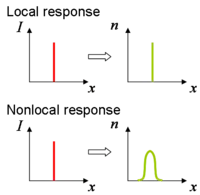In optics, a nematicon is a spatial soliton in nematic liquid crystals (NLC). The name was invented in 2003 by G. Assanto.[1] and used thereafter [2][3] Nematicons are generated by a special type of optical nonlinearity present in NLC: the light induced reorientation of the molecular director (i.e. the average molecular orientation). This nonlinearity arises from the fact that the molecular director (i.e., the optic axis of the corresponding uniaxial) tends to align along the electric field of light. Nematicons are easy to generate (with mW optical power or less [4][5][6]) because the NLC dielectric medium exhibits the following properties:
- A very large nonlinear response : the effective nonlinearity is typically eight orders of magnitude larger than that of carbon disulfide. This means that much lower optical powers are necessary to obtain the same refractive index variation (increase) or self-focusing to balance out diffraction.
- A nonlocal response : the nonlinear response is not limited to the location of the optical field. Instead the response profile is wider than the light beam. A high nonlocality allows for stable soliton propagation even in the case of two transverse dimensions. Higher or lower powers than the exact value required for a soliton to exist lead to breathing solitons.[7][8][9]

- A saturable all-optical response: the director of the liquid crystal tends to align along the electric field of the light beam. For powerful beams the molecular director becomes parallel to the field and no further reorientation is possible. Response saturation also stabilizes two-dimensional solitons.
Since the reorientational optical nonlinearity of nematic liquid crystals is accompanied by an electro-optic response to low-frequency electric fields, i.e. applied voltages, nematicons and the associated waveguides [10] can be steered in angle and routed in space by the application of an external bias, leading to reconfigurable interconnects.[11][12]
In waveguide arrays where discrete solitons are knows to form,[13] discrete nematicons have also been demonstrated [14][15]
See also
References
- ↑ G. Assanto; M. Peccianti; C. Conti (2003). "Nematicons: Optical Spatial Solitons in Nematic Liquid Crystals". Optics and Photonics News. 14 (2): 44–48. Bibcode:2003OptPN..14...44A. doi:10.1364/OPN.14.2.000044.
- ↑ G. Assanto & M. Karpierz (2009). "Nematicons: self-localized beams in nematic liquid crystals". Liq. Cryst. 36 (10–11): 1161–1172. doi:10.1080/02678290903033441. S2CID 121925099.
- ↑ M. Peccianti & G. Assanto (2012). "Nematicons". Phys. Rep. 516 (4–5): 147–208. Bibcode:2012PhR...516..147P. doi:10.1016/j.physrep.2012.02.004.
- ↑ J. Beeckman; K. Neyts; X. Hutsebaut; C. Cambournac; M. Haelterman (2004). "Simulations and Experiments on Self-focusing Conditions in Nematic Liquid-crystal Planar Cells". Opt. Express. 12 (6): 1011–1018. Bibcode:2004OExpr..12.1011B. doi:10.1364/OPEX.12.001011. PMID 19474916. S2CID 22914616.
- ↑ M. Peccianti; A. De Rossi; G. Assanto; A. De Luca; C. Umeton & I. C. Khoo (2000). "Electrically Assisted Self-Confinement and Waveguiding in planar Nematic Liquid Crystal cells". Appl. Phys. Lett. 77 (1): 7–9. Bibcode:2000ApPhL..77....7P. doi:10.1063/1.126859.
- ↑ A. Piccardi, A. Alberucci & G. Assanto (2010). "Self-turning self-confined light beams in guest-host media". Phys. Rev. Lett. 104 (21): 213904. Bibcode:2010PhRvL.104u3904P. doi:10.1103/PhysRevLett.104.213904. PMID 20867102.
- ↑ A. Snyder; D. Mitchell (1997). "Accessible Solitons". Science. 276 (5318): 1538–1541. doi:10.1126/science.276.5318.1538.
- ↑ C. Conti, M. Peccianti & G. Assanto (2003). "Route to nonlocality and observation of accessible solitons". Phys. Rev. Lett. 91 (7): 073901. arXiv:physics/0308024. Bibcode:2003PhRvL..91g3901C. doi:10.1103/PhysRevLett.91.073901. PMID 12935018. S2CID 13532247.
- ↑ C. Conti, M. Peccianti & G. Assanto (2004). "Observation of optical spatial solitons in a highly nonlocal medium". Phys. Rev. Lett. 92 (11): 113902. arXiv:physics/0403032. Bibcode:2004PhRvL..92k3902C. doi:10.1103/PhysRevLett.92.113902. PMID 15089136. S2CID 30524614.
- ↑ M. Peccianti & G. Assanto (2001). "Signal readdressing by steering of spatial solitons in bulk Nematic Liquid Crystals". Opt. Lett. 26 (21): 1690–1692. Bibcode:2001OptL...26.1690P. doi:10.1364/ol.26.001690. PMID 18049701.
- ↑ M. Peccianti; C. Conti; G. Assanto; A. De Luca; C. Umeton (2004). "Routing of Highly Anisotropic Spatial Solitons and Modulational Instability in liquid crystals". Nature. 432 (7018): 733–737. Bibcode:2004Natur.432..733P. doi:10.1038/nature03101. PMID 15592407. S2CID 4424339.
- ↑ M. Peccianti; A. Dyadyusha; M. Kaczmarek; G. Assanto (2006). "Tunable refraction and reflection of self-confined light beams". Nat. Phys. 2 (11): 737–742. Bibcode:2006NatPh...2..737P. doi:10.1038/nphys427.
- ↑ F. Lederer; G. I. Stegeman; D. N. Christodoulides; G. Assanto; M. Segev; Y. Silberberg (2008). "Discrete Solitons in Optics". Phys. Rep. 463 (1–3): 1–126. Bibcode:2008PhR...463....1L. doi:10.1016/j.physrep.2008.04.004.
- ↑ A. Fratalocchi; G. Assanto; K. A. Brzdąkiewicz; M. A. Karpierz (2004). "Discrete Propagation and Spatial Solitons in Nematic Liquid Crystals". Opt. Lett. 29 (13): 1530–1532. Bibcode:2004OptL...29.1530F. doi:10.1364/ol.29.001530. PMID 15259736. S2CID 31424691.
- ↑ G. Assanto, A. Fratalocchi & M. Peccianti (2007). "Spatial solitons in nematic liquid crystals: from bulk to discrete". Opt. Express. 15 (8): 5248–5259. Bibcode:2007OExpr..15.5248A. doi:10.1364/oe.15.005248. PMID 19532777.
External links
- Spatial optical solitons in liquid crystals Archived 2007-08-14 at the Wayback Machine, a short introduction (Ghent University).